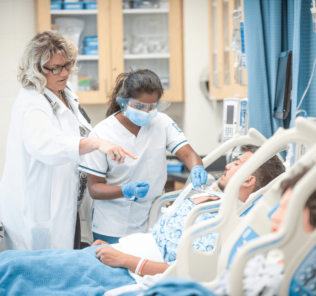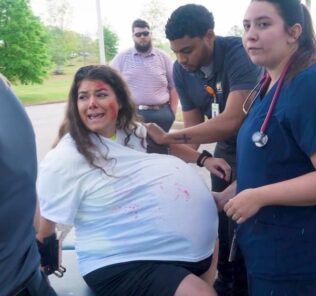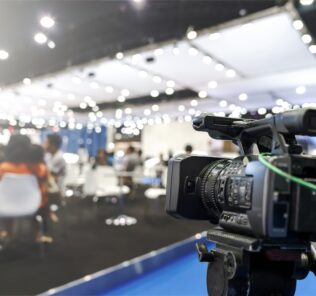Filling a Real Demand for Simulated Care, Avkin Startup Partners for Innovative Success
Recently on the University of Delaware’s website Amy Cowperthwait, Founder & CEO of Avkin was interviewed to share more about the successful partnerships that have developed through the University to bring innovation into our field of healthcare simulation. Beth Miller, Science Writer from UD’s Office of Communications, fills us in!
Amy Cowperthwait has a good recipe for blood if you ever need one. Good consistency, good color (unless you’re a green-blooded skink) and it flows the way it’s supposed to. No, she’s not a chef for Count Dracula. She’s a clinical nurse specialist in the University of Delaware’s Nursing Resource Simulation Center, and she has been cooking up packs of the plasma-like product to help nursing students, medical technicians and others learn the art of drawing blood.
It will be part of a kit her new company—Avkin—produces to help learners practice such procedures in realistic ways using silicon “skin” that has similar resistance to a needle, for example, and this fake blood that is drawn into an intravenous catheter just as real blood would be in a clinic.
Sponsored Content:
With such experience, her UD students enter clinical settings with much greater confidence and skill. They are far less likely to be the “night nurse from hell” that one tracheostomy patient described to Cowperthwait—doing suction procedures that went too deep, went on too long and did way too much. “If that nurse could just get re-trained and hear about their patient’s experience, I am 100 percent positive they would change their care,” Cowperthwait said.
Avkin (formerly known as SimUCare) is one of a growing number of success stories emerging from UD’s Office of Economic Innovation and Partnerships, which shepherds viable new products developed by faculty and students to the marketplace.
Cowperthwait’s work was fueled by grants and prizes as products were developed and tested and the company was named one of the best startups in the nation by the National Council for Entrepreneurial Tech Transfer in 2016. A business investor has added fresh vigor to the company’s growing list of products.
From simulated tracheostomy care (Avtrach) to drawing blood (Avstick) and urinary catheter placement (Avcath), Avkin has a list of seven devices either on the market, in final testing or in various stages of development. All have emerged from UD engineering students’ senior design projects—a partnership Cowperthwait hopes to continue as new prototypes emerge.
Sponsored Content:
The new devices and the simulation technology embedded within them are unique, even more so when worn by students enrolled in a course taught by faculty in UD’s Healthcare Theatre, a program Cowperthwait co-founded with Allan Carlsen of the Department of Theatre. Students practice on these actors, who respond in real time to haptic signals, such as vibrations, from electronic sensors.
The devices may indicate that excessive force has been used, for example, and the actor may holler “Ouch!” The devices have anatomically correct features. They produce sounds—and sometimes smells—that correspond to those typical to the situation. It can get intense.
“I saw so many new nurses who had solid technical skills struggle with the real-life matter of caring for the person behind the critical need and their family. What was missing in their education? The human element,” she said. “Nursing students were learning medical procedures on plastic models but not the interaction challenges of communicating with live human patients during their times of greatest need.”
The School of Nursing’s Resource Simulation Center exists to help students learn what to say, what to ask, how to respond.
“I could talk the paint off the walls,” said Haaf, now on the staff at the University of Maryland Medical Center in Baltimore. “I can hold a conversation with anyone or anything. But being able to work with the devices and the actors made it that much more realistic and much easier for students who couldn’t talk to a manikin. It makes our school unique in that way and makes us that much better nurses.”
None of this machinery was in Cowperthwait’s Plan A when she joined UD’s faculty in 2006 after 28 years as an emergency-room nurse. But innovation happens. “It’s really good to get nurses and engineers together,” Cowperthwait said. Add the theatre students and you have “beautiful, beautiful synergy” and a great environment for innovative ideas and solutions.
For expertise in design, manufacturing, business practice and marketing, she worked with mechanical engineering students and faculty, including Jenni Buckley and Liyun Wang of the College of Engineering, and had guidance from Joy Goswami, assistant director of the Tech Transfer Center in OEIP, in addition to UD’s Horn Program in Entrepreneurship, the Delaware Biotechnology Institute and the Alfred Lerner College of Business and Economics.
Since Avkin’s launch in 2016, the back room of its New Castle, Delaware, headquarters has morphed into a small-but-intriguing makerspace, where rubber tubing and bits of silicon, razor knives, bubble wrap and assorted adhesives are stocked beside red dyes, hypodermic needles and a plastic tub used when cooking up synthetic blood.
It now has seven full-time employees and five part-timers. “We see our relationship with the University as not ending,” Cowperthwait said. “We will always start our product development through the University’s senior design program. The company’s founders believe in education and there is a symbiotic relationship. We have theatre, nursing and engineering students working together—where does that even happen? We will keep innovating and moving forward.” And patients and their caregivers will reap the rewards.
Read the Full Story about Amy and Avkin on the UD Website today!
Sponsored Content:



















